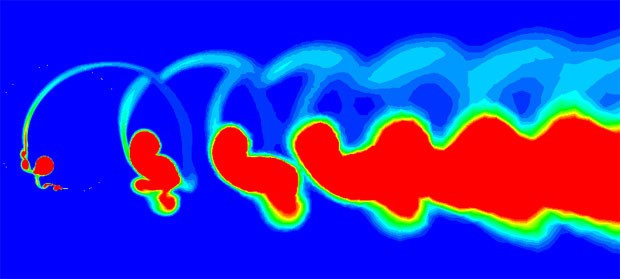University researcher is redesigning turbine blades to generate more power

To boost capacity, wind power generation needs to be more efficient. Jennifer Tan, a master’s student in the Department of Mechanical, Industrial, and Aerospace Engineering, is looking at how to make that happen by redesigning wind turbine blades.
Under the supervision of Marius Paraschivoiu, Tan uses computational fluid dynamics (CFD) to study the aerodynamic effect of applying morphing blades on vertical axis wind turbines (VAWTs). "I aim to show how VAWT performance can be improved to make it more viable," she says.
Now, the wind power industry is dominated by horizontal axis wind turbines (HAWTs). However, VAWTs are most suitable for urban environments, so represent a promising route for the future of wind power generation.

The quest for a better alternative source of energy
How does the specific image above relate to your research at Concordia?
The image shows the turbulent viscosity generated by a single-bladed VAWT. The blade has just gone through stall: it lost a significant amount of lift and increased its drag due to the large angle of attack. Flow separates from the blade at high angles of attack and sheds vortices or highly rotational flow that could disrupt the flow when the blade interacts with the vortex shed from the previous cycle.
One of the main issues being addressed in my research is how to increase the regions that generate the most power in a given cycle while delaying the occurrence of stall, as well as preventing blade-vortex interaction as much as possible with the use of a morphing blade mechanism.
What is the hoped-for result of your project? And what impact could you see it having on people's lives?
The research aims to show how the use of morphing blades improves the aerodynamic performance, and therefore the power generation capability, of the vertical axis wind turbine.
I aim to show how VAWT performance can be improved to make it more viable. Since VAWTs are used mostly in urban settings, like on top of buildings and infrastructures, improving their performance could lead to a better alternative source of energy generation.
What are some of the major challenges you face in your research?
Some major challenges in the field of CFD include the proper implementation of your simulation model and methods to make sure they capture the physics of what you are simulating.
Another challenge is the balance between computational cost and the accuracy of the solution. When resolving a complicated flow behaviour, more computational cost may be required for a desired amount of accuracy. However, this computational resource might not be available, so you have to strike up a balance between what is feasible with respect to the amount of accuracy you desire.
What person, experience or moment in time first inspired you to study this subject and get involved in the field?
Taking the course Numerical Methods in Engineering inspired me to pursue the field of CFD. I thought it was brilliant how we could break down an analytical equation into discrete forms and let the computer handle the computations.
I find that producing your own numerical code to solve problems is like transferring your thought process to another entity, so whenever you encounter a similar problem you just call on this entity you created. The best feeling is when you do the verification and validation and find that your code or method works as it should.
How can interested STEM students get involved in this line of research? What advice would you give them?
Have a good sense of curiosity, a love of solving problems, and a good mathematical background. CFD is a multidisciplinary field; although it is usually associated with mechanical and aerospace engineering, people with backgrounds in math, physics, and computer science are very well suited for it.
What do you like best about being at Concordia?
I like that the downtown campus is perfect for a student’s lifestyle, since everything is close by. The student community, as well as the faculty, are very supportive of each other. Whether it is participating in inter-collegiate competitions or working with professors on their research, there are plenty of avenues for students to apply their knowledge outside the classroom.
Are there any partners, agencies or other funding or support attached to your research?
The morphing blade profiles are provided by Alexander Pankonien, a research aerospace engineer at the Airforce Research Laboratory (University of Michigan), and Daniel Inman chair of the Department of Aerospace Engineering at the University of Michigan.
All the computations for the study were made possible through the supercomputer Briarée from l’Université de Montréal, managed by Calcul Québec and Compute Canada.
The operation of the supercomputer is funded by the Canada Foundation for Innovation (CFI), the ministère de l’Économie, de la science et de l’innovation du Québec (MESI) and the Fonds de recherche du Québec – Nature et technologies (FRQ-NT).




